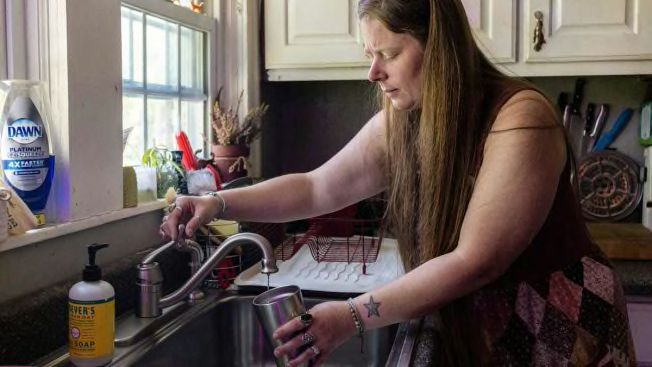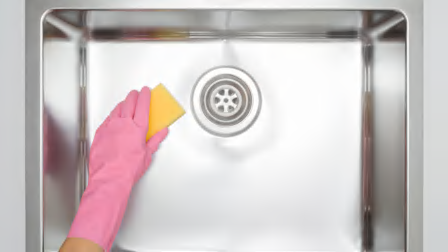Dangerous PFAS Chemicals Add to Mississippi’s Water Woes
The 'forever chemicals' were found in 98 percent of samples in the state tested by Consumer Reports

Crystal and Tim Dotson, of Corinth, Miss., were spooked after watching “The Devil We Know,” a documentary about how the scarily named “forever chemicals” contaminated public soils and streams for decades.
Curious to know if the chemicals, also called PFAS, were affecting them, the Dotsons decided to have their water tested. As they discovered, their water contained PFAS at levels much higher than what public health experts consider safe.
“It was staggering,” Crystal says.
See Consumer Reports’ recommendations for water filters that remove PFAS and learn how to get forever chemicals out of your drinking water.
While it’s nearly impossible to tie specific health symptoms to water contamination, the Dotsons say they’ve encountered a myriad of concerns since moving to their Corinth home five years ago. Tim has suffered recent bouts with kidney disease, cancer, and high blood pressure, the latter two of which have been linked to PFAS.
The Dotsons and their four kids drink the tap water through a Brita filter, but standard filters like those can’t fully eliminate PFAS. Crystal and Tim, who both live off government disability payments, say they can’t afford more advanced filtration systems.
(Consumer Reports has identified four water filters, including two pitchers and two under-sink models, that can help consumers filter out forever chemicals.)
While the couple were encouraged by recent settlements in civil litigation against manufacturers like DuPont and 3M, they’re scared of what the water might be doing to their family’s bodies.
“It’s the only water that we have,” Crystal says. “This is our home.”
John Rhodes, the general manager for Corinth’s water department, said he wasn’t aware of high PFAS levels within the city, largely because Mississippi has no testing requirements.
“Unless it’s something that’s regulated, I’m not going to be totally aware of it,” Rhodes said.

Photo: Eric Shelton/Mississippi Today Photo: Eric Shelton/Mississippi Today
The Troubled History of PFAS
After scientists invented PFAS in the 1930s, manufacturers realized how valuable an ingredient it could be. The chemicals became widely used in tools like firefighting foam in the military, and in an array of consumer products like furniture stain repellents, non-stick cookware, and food packaging.
But those manufacturers and the Department of Defense eventually learned of the dangers of PFAS to those who go near or are exposed to the chemicals. In 2018 ProPublica reported that both the government and manufacturers were slow to reveal the threat of PFAS to the public, and documents in an ongoing lawsuit against several PFAS manufacturers reveal that companies hid the risks for decades.
There’s limited knowledge of how widespread PFAS in Mississippi are. Just about a dozen states, Mississippi not included, are either regulating or proposing limits on PFAS in drinking water.
An EWG map of DOD data shows nine sites in the state where the military used firefighting foam containing PFAS. While the military is phasing out use of PFAS, the data from groundwater samples at those sites shows PFAS levels that, in some cases, were thousands of times higher than the limits the EPA is proposing.
Read more about CR's investigation into Mississippi's water quality.
• Forever Chemicals’ in Drinking Water Are Worrying Mississippi Residents
• Mississippi’s Water Utilities Prepare for New Rules on PFAS in Drinking Water
• Lead Is Common in Mississippi Drinking Water, Consumer Reports’ Tests Find
What CR's PFAS Tests Found
As shown above, the samples with the highest levels of PFAS came from Corinth, Vaiden, Hattiesburg, Gulfport, Lexington, and Tchula.
Homeowners with some of the higher levels of PFAS offered a wide range of reactions, from concern, to confusion, to indifference.
Shawn Harris, a banker in Hattiesburg who also runs the Piney Woods Conservation Group, wrote to the EPA urging it to enforce standards limiting PFAS. But even Harris, whose test results showed a total PFAS level of 9.6 ppt, says it’s puzzling trying to figure out what those numbers mean.
“It’s really hard to follow,” Harris says. “When I first got the results I was like, ‘Oh, dang, I’m good, but not that good.’”
Even though he drinks bottled water, he says he’s looking to get an under-the-sink filter for the tap water he gives his pets.
Other volunteers, though, were less concerned. Alan Wilson sent in a sample from his remote weekend home in Lexington, showing 43.4 ppt of total PFAS, one of the highest results in the study.
“When you think about 43 parts per trillion, that’s not much,” he says, adding that he didn’t know why there would be PFAS contamination given that there aren’t any businesses near the property. “So, no, I guess I don’t get too excited about it. It doesn’t scare me.”
It’s unclear how well or how soon local water utilities will be able to filter out PFAS. Once an EPA rule is finalized, utilities will have three years to come into compliance. Even then, many local systems are worried about the associated costs and having to pass on large rate hikes to customers.
In the meantime, the Dotsons hope that more accountability comes for the years of PFAS contamination, including giving support and water filters directly to those impacted.
Since learning what was in their tap water, the Dotsons have started drinking from store-bought bottles, costing them about $15 a week. Crystal said they started seeing improvements in Tim’s health within a week of the change. As for what happens next, she said she hopes for more accountability over the release of PFAS into public water sources.
“Somebody should go to jail over it,” Crystal Doston says. “They need to dissolve those companies and disperse that money to the people that were hurt."
Editor’s Note: This investigation was conducted by Consumer Reports in partnership with Mississippi Spotlight, a collaboration between Mississippi Today and other news outlets in the state.




















